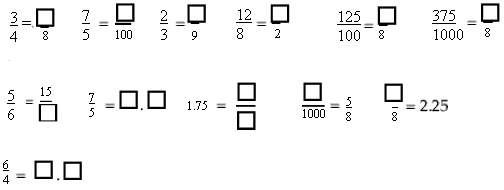Know benchmarks for converting between common fractions, decimals and percentages.
Number Framework Stage 7
Deci-mats (Material Master 7-3), whole laminated copies and paper copies
Using Materials
Give the students a copy of the whole deci-mat with no divisions. Tell them that they have been given one deci-mat each. Ask them to draw a line that cuts their mat in half and to cut along the line. Tell them that you want them to fold the one-half into quarters.
.gif)
Ask them what fraction of one these new pieces will be (one-eighth). Their answers can be verified by going back to one deci-mat. Ask, “How many eighths make one half?” (four). Record this as 4/8 = 1/2. Carry out similar actions on other fractions. For example:

Record this as 9/12 = 3/4.
Ask the students to find out how many sixths are the same as two thirds. Record this as 4/6 = 3/2. Look for the students to establish relationships between the numbers in the equations and relate them back to the deci-mat model.
For example, “If you cut quarters into three equal parts you get twelfths. So three quarters will be nine-twelfths, three times as many.”
Remind the students that the decimal system only allows tenths, hundredths, thousandths, etc. to be used in renaming fractions as decimals.
Provide them with a new deci-mat and ask them to use the marks to draw on the mat lines that cut it into tenths.
After this, provide them with another deci-mat that is divided into tenths. Ask them, “If each tenth were cut into 10 equal parts how many parts would that make?” (100) “What would each part be called?” (one hundredth). Get the students to use the marks on the deci-mat to draw the hundredth partitions.
Provide the students with a copy of the deci-mat divided into thousandths and ask them how the parts were created.
Challenge them to work co-operatively to find out how many tenths, hundredths, and thousandths are equivalent to the following fractions:1/2 , 1/4 , 1/5 , 1/8 , 1/10
Record their findings in a chart to highlight the patterns:

Record the equivalence of fractions as equations, e.g., 1/2 = 5/10 = 50/100 =500/1000.
Challenge the students to explain why it is not possible to divide the deci-mat into thirds using the lines. (One-third is not equivalent to an exact number of tenths, hundredths, or thousandths.)
Using Imaging
Cut out some non-unit fractions using photocopies of the deci-mat. For example, cut out 3/5 (6 tenths). Turn the fraction piece over so that the lines are not visible. Place it on top of a laminated version of the deci-mat that is also turned over. Label the paper piece with the fraction symbol.
Challenge the students to tell you how many tenths, hundredths, and thousandths the fraction is equivalent to. Record their solutions, using both tables and equivalent fraction statements.

Check the students’ ideas by turning over both the deci-mat and the fraction piece so that the lines are visible.
Provide other similar fractions for the students to image, e.g., 3/4 , 7/8 , 9/10, and 4/5. Include fractions that have simple equivalents, like 4/8 and 8/10, and fractions greater than one, like 5/4 and 8/5, so that the students generalise the concept.
For example: 8/5 would be:
Record an equivalence statement and ask the students if they notice any pattern in the fractions. For example: 4/3 = 100/75 = 1000/750
Students should notice multiplicative relationships across the equations like, “To get 75 hundredths, you multiply both numbers by 25.” Ask them why both numbers are multiplied by the same number. Refer back to the materials if necessary with questions like, “How many parts is each quarter cut into to form hundredths?” (25).
Using Number Properties
Give the students problems that require them to rename fractions as equivalent forms or decimals. For example:

Look for the students to be able to work between and within the fractions. For example:
Independent Activity
Playing the game of Create Three (see Material Master 7-9) will reinforce students' knowledge of simple equivalent fractions.

